 |
||
|
||
| ||
Production, technologies, equipmentMark my words: these times are to go down in semiconductor industry history as one of the brightest periods of research and productive resources consolidation. There are two tendencies. One of the brightest and the most typical is the unification of research-and-development centers, aimed at the successful transition to the next-generation chip production with the minimal R&D expenses due to budget consolidation. Simultaneously, large and more or less confident industry leaders now try to buy up their "rivals-in-debt" that nevertheless own the impressing patent packs or a number of production facilities. However, such noticeable deals like the failed purchase of Hynix by Micron are rather rare. The absorbtion of smaller companies, mostly lucky start-ups, is a rather usual and continuous process. But what's more important, serious industry brands still often unite R&D centers with their rivals'. But there are not so many alternatives here: to partner or to spend the lion's share for R&D, or just to be left behind with outdated technologies. News contains more and more merger announces. Sony together with its Sony Computer Entertainment Inc. (SCEI), IBM, and Toshiba announced the joint efforts for the industry implementation of 0.09-0.045-micron technical processes on 300-mm silicon wafers. Like in the most cases companies do not plan to build joint facilities, each of them is going to implement the joint developments on its own fabs. IBM is going to launch its 0.09-micron chip factory on 300-mm wafers in the end of 2002. I presume the first products to be chips developed for IBM's Cell project ("supercomputer-on-a-chip"). The transition to 65 nm and 45 nm is to happen in 2004 and 2006, respectively. Sony is going to use the IBM's "Cell" architecture in its PlayStation 3 console, that's to be released next year. In general the R&D partnership program looks considered enough: IBM is going to pass its SOI developments to the Japanese Sony and Toshiba. The group of scientists and engineers from IBM, Sony, and Toshiba will be developing SOI and other technologies in the IBM Semiconductor Research and Development Center (SRDC). According to the preliminary plan, the companies are going to spend several hundreds million dollars for this program during four years. Another bright research alliance of STMicro and Philips, announced at SPIE in February, was replenished with a freshman member - Motorola. Now the three largest semiconductor manufacturers - STMicroelectronics, Motorola, and Philips - being the third, 7th, and 10th in the world's electronic industry top, respectively, have joined their resources for the joint technological developments. Some analysts believe the new R&D alliance to be not triple, but multiple. Most possibly, Motorola will join the Philips, ST, and TSMC partner program for speeding up the introduction of the 0.09-micron technical process on 300-mm silicon wafers, announced in February. Now the project is enriched with Motorola's experience of SOI (silicon-on-insulator) technology development. Possibly Motorola and AMD partnership program will evolve since April. The latter has recently organized the joint research & manufacture venture together with the Taiwanese UMC. The companies are building a 300-mm fab in Singapore, simultaneously jointly developing the 65 nm technical process. Texas Instruments's position is rather interesting. In April it reported the intention to order from both TSMC, and UMC from the second half-year of 2002. This is a logical continuation of TI's strategy of cutting expenses and increasing profits by passing a part of the manufacture to Taiwanese companies. TI also plans to use 90 mm technical processes of TSMC and UMC for the next several years. However, the cooperation of Texas Instruments with Taiwan is rather specificial and doesn't seem like usual outsourcing: according to terms of the agreement, TI will use TSMC and UMC for its own copper CMOS process. TI will re-equip its DMOS 6 fab in Dallas for the new 300-mm wafers technical process in the end of the year. Another R&D alliance - Leepl Consortium, developing the E-beam technology, was replenished with five new freshman members in April: Hitachi, Mitsubishi Electric, Seiko Epson, Joel (Tokyo), and NaWoTec (Ãepmahèÿ). Now Leepl Consortium founded in June 2001 consists
of 24 companies, including: Matsushita Electric, NEC, Rohm, Sharp,
Sony, Texas Instruments, Dai Nippon Printing, Hoya, NTT Advanced
Technology, Toppan Printing, Fiji Film Arch, JSR, Shin-Etsu Chemical,
Shipley Far East, Tokyo Ohka Kogyo, Leepl, Tokyo Seimitsu, Toshiba
Machine, and Nippon Control System. 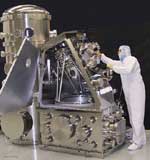 Intel is more often in the technological/manufacture spotlight than other companies. Remaining the market leader, it is forced to be among the first implementing the newest technologies, so Intel is mostly said as "world's first something" in the news. In April Intel ordered the world's first EUV lithographic tools from Dutch ASML. Beta versions of such EUV tools will be delivered for equipping production lines for Intel P1266 (0.045 micron and smaller) technical process, presumably, on the 300-mm fab in Hillsborough, Oregon, USA. Intel plans to purchase more industrial plants from ASML. It will possibly happen in 2006. Now Intel produces chips with P860/1260 technical processes, working with 0.13-micron elements (P860 - 8" wafers, 1260 - 12" ones). Nikon's 248 nm lithographic tools are used for critical parts. Intel is going to transit to the P1262 technical process (0.090 micron), using 193 nm and 248 nm scanners in 2003. Then about 2005 Intel plans to launch the production of chips according to the P1264 technical process (0.65 micron) using 157 nm scanners. EUV systems will be used with Intel P1266 technical process for the first four critical layers with 45 nm elements: insulators, gates, contacts, the first layer of metallic semiconductors. 157 nm tools will be used for other layers of 45 nm process. The first quarter of 2002 has finished with the adoption of the several new standards. So, the group of industry leading companies, including Hitachi, Matsushita, Philips, Silicon Image, Sony, Thomson, and Toshiba announced the development of specifications of a digital interface for the next-generation consumer electronics - digital TVs, DVD players, consoles, and other A/V devices. The High Definition Multimedia Interface (HDMI) combines the HDTV and multiple-channel audio support in a single digital interface. HDMI bases on the DVI specs, being backward compatible with it. The new specifications specify the usage of a miniature jack, suitable for mobile devices. Being founded on the compatibility with the CEA (EIA/CEA-861x) standards, HDMI ensures lossless video transmission between source and the display. Besides, HDMI will support the majority of European AV.link-compatible protocols. The new standard will also support the new High-bandwidth Digital Content Protection (HDCP) standard, developed by Intel and Silicon Image for the DVI interface. PCI-SIG workgroup, developing the 3GIO (3rd Generation I/O) bus, has renamed the project to PCI Express. PCI Express 1.0 specs for mobile applications are to be adopted first. All other specifications will be adopted in the second half-year. The initial implementation of the PCI Express bus is expected in 2003 after the first compatible products appear. Except for Intel itself, VIA and SiS are also preparing chipsets supporting PCI Express, and NVIDIA and ATI actively participate in the development of a new standard graphics bus. PCI Express is expected to gain wide adoption in 2004. In April Intel published the final version of its royalty-free USB 2.0 EHCI 1.0 (Enhanced Host Controller Interface) specifications. The company has been developing EHCI together with Agere Systems, Compaq Computer, Microsoft, NEC, and Philips Semiconductors. At creation of the USB 2.0 EHCI 1.0 Intel considered the difficulties with releasing drivers for two existing USB 1.0 specifications at once: UHCI and OHCI. ProcessorsIn April iXBT.com launched the new CPU.RightMark project for creating a set of measuring tests for CPU efficiency and performance estimation. The CPU RightMark (CPU RM) test is designed for the objective measuring of performance of the current and future processors in a variety of computing tasks such as computational modeling of physical processes and 3D-graphics computing. The emphasis is placed on the CPU-RAM bundle and FPU/SIMD blocks testing. Being a fully open source project, CPU.RightMark bears the idea of trustworthy, reliable tests creation and, as it's the open-sourced, the opportunity of controlling test principle and results by independent experts.  The first version of the test is not intended for SMP systems, but further versions are planned to support this feature. The project is fully independent and non-commercial. This ensures the equity and objectivity of the test system. The test source code is open and available for everybody. The CPU.RightMark project is located here. March started with Intel releasing the new 2.40 GHz desktop Pentium 4 with 512 KBytes L2 cache and FSB 400 MHz. The new CPU features 57.8 W power consumption and can be delivered in both OEM, and retail packages.
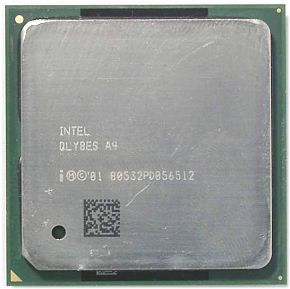
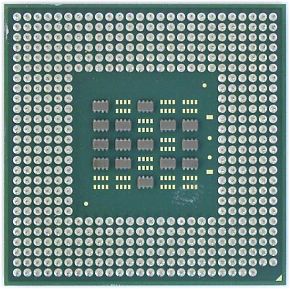 Read more about the performance of the new 2.4 GHz CPU in our Comparative performance testing of Intel Pentium 4 2.4 GHz, AMD Athlon XP 2100+ and their predecessors. This totals the April desktop novelties of Intel. The beginning of May has to be really interesting as Intel announces the new Pentium 4 with 533 MHz bus. 2.26 GHz and 2.4 GHz variants are to be released first. But April brought a nice yield of Intel's mobile processors, that is eight new models:
All novelties are made according the 0.13-micron technical process. It seems Intel isn't going to give the rivals a chance to enter the market segment unoccupied by its processors. Along with old models cancellation, the company releases novelties counting on the full market occupation. At the end of the month Intel announced the release of the 2.4 GHz Xeon CPU for dual-processor server platforms and workstations. Like the predecessors the novelty has 512 KBytes L2 Advanced Transfer Cache, and is made according to 0.13-micron technical process. It's the first CPU for dual-processor platforms made from 300-mm wafers.  In April the most "heavyweight" sector of Intel's 64-bit CPUs brought two remarkable news. Intel announced that the next generation of Itanium CPUs are named Intel Itanium 2 henceforward. This brand will be used in the market for processors, previously codenamed McKinley. Itanium 2 family will be appearing closer to the middle of 2002, and systems based on them - closer to the year-end. In April Intel also announced it had produced the first silicon samples of Madison CPU. The mass production of these 0.13-micron processors is planned to the next year. The Madison line will feature up to 6 MBytes L2 cache (vs. 3 MBytes of Itanium 2 or McKinley) and contain up to 500 million transistors (Itanium 2 - up to 220 million transistors). From the angle of AMD's processor releases April was rather moderate. In the beginning of the month it presented Alchemy Au1100 MIPS32 CPUs for mobile Internet tablets, PDA, and automobile appliances. 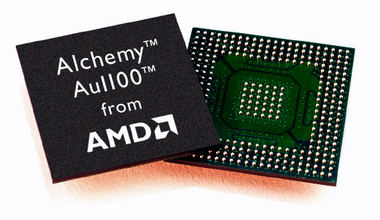 Au1100-based systems can work under Windows CE/CE.NET, Linux, and VxWorks. Au1100 feature the power-saving work mode - 333 MHz version needs less than 200 milliwatt, 400 MHz version - less than 250 milliwatt, 500 MHz one - less than 500 milliwatt. Processors feature a wide variety of integrated interfaces: 10/100 Ethernet MAC, USB, IrDA, AC'97, I2S, SSI, Secure Digital (SD), PCMCIA, LCD (up to two color LCD panels, STN and TFT, up to 1024 x 1024 x 16 bit); 100 MHz SDRAM, SRAM/Flash EPROM controllers, etc. Clearly this states the merger of Alchemy into AMD is finished. After the AMD Au1100 announce we should await the next generation of MIPS32 processors - AMD Au1500. Besides, at the end of the month AMD licensed MIPS64 instruction set from MIPS Technologies. The license for the MIPS64 Instruction Set Architecture (ISA) will enable AMD develop the 64-bit processors supporting the MIPS64 standard. We didn't see the desktop Athlon XP with Thoroughbred core in April. According to some sources, they'll appear not before the middle of May. But AMD's 0.13 micron technical process made its debute. The company reported the release of a mobile Athlon XP. 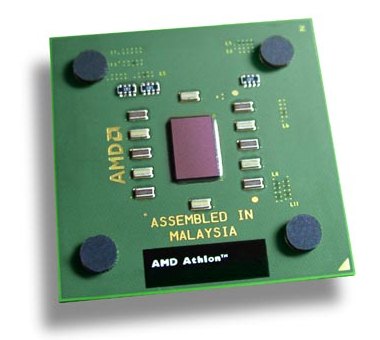 This release of a mobile CPU under the Athlon XP brand instead of the usual Athlon 4 seems strange. Perhaps, AMD is going to separate models, made according to different technical processed - 0.13 micron and 0.18 micron. The mobile Athlon XP is labelled according to the usual QuantiSpeed doctrine: AMD Athlon XP 1400+ (1.2 GHz actual clock rate). The new CPU supports FSB 266 MHz, AMD 3DNow! Professional and AMD PowerNow! Instruction sets. Other April news about AMD touched upon prospects only. So, according to the updated company roadmap, the Barton core, that is to replace Thoroughbred in the second half-year of 2002, will feature 512 KBytes L2 cache. However, there's the fly in the ointment: the company decided not to use the silicon-on-insulator (SOI) technology in Barton. SOI will be used only in the next generation of 64-bit Hammer processors. 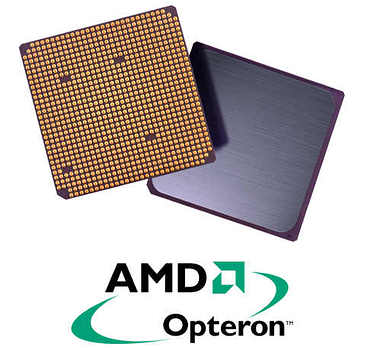 Besides, AMD has officially announced that the eight-generation chips for multiprocessor (1x - 8x) servers and 1x - 2x workstations, planned to be shipped in the first half-year of 2003, are not named SledgeHammer anymore. They are branded AMD Opteron henceforward. AMD Opteron is not a marking of a single CPU, but the chip family brand. According to the provisional data, workstation and server processors will have other and most likely different codenames. AMD's registered trademarks include AMD Fortan, AMD Vanton, AMD Metaron, and AMD Multeon, as well as simply Opteron and Metaron plus Jenero64. Server CPUs of the AMD Opteron line are known to feature up to 1 MBytes L2 cache. Workstation CPU L1 cache will be 128 KBytes (64 KBytes data cache plus 64 KBytes instruction cache), L2 will be up to 1 MBytes. We, however, will have to forget not only the SledgeHammer codename: Clawhammer chips are to leave the lexicon as well, most likely they'll become "64-bit Athlons" (see the photo below). 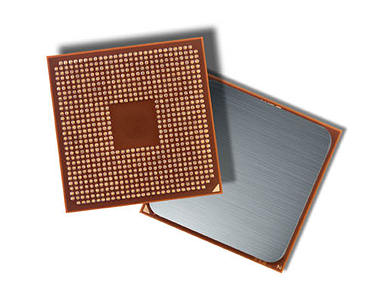 April brought the important news on the official announcement of AMD and Microsoft about the support of 8-generation AMD Athlon and AMD Opteron CPUs by the future versions of Windows operating systems. AMD Opteron will also be supported by 64-bit OSes by the leading Linux developers. Mainboards and chipsetsAlas, in April the general state of the mainboard market can be characterized as "Awaiting the new May chipsets from Intel". The chipset names are known long ago: i845G, i845GL, i845E, i850E; many systemboards were demonstrated on the CeBIT 2002 in March. However all data is held until the official chipset announcement in the beginning of May. Despite existing chipset photos and ready boards showcased in Japanese shops, all info is still semi-official (below: i845G chipset).  Though the message, that Intel prepares an inexpensive version of its 845GL integrated chipset, still codenamed 845GLL or 845GL Light, appeared in April. 845GL and 845GL Light differ by the "older" North Bridge of the latter, completed by the ICH2 South Bridge supporting only USB 1.1. This allows to reduce the price of 845GLL below $25. In April some Web sources reported that SiS prepares its version of an RDRAM chipset. SiS R658 supporting PC1066 RDRAM will appear in the 3rd/4th quarters of 2002. It will support Pentium 4 with FSB 400/533 MHz, AGP 8x, 4i PC1066 RDRAM. SiS R658 will be completed by the SiS963 South Bridge, the performance of interconnect bus being up to 1066 MBytes/s. SiS963 will automatically enable the ATA133 support on the SiS R658 boards along with IEE1394 and USB2.0 interfaces. Though SiS itself hasn't approved this anyhow. In April VIA Technologies announced the deliveries of the EPIA mainboards in the Mini-ITX (170 x 180 mm) package. It's an economical solution for systems without cooling, featuring EdenT ESP or VIA C3T E CPUs (up to 800 MHz). 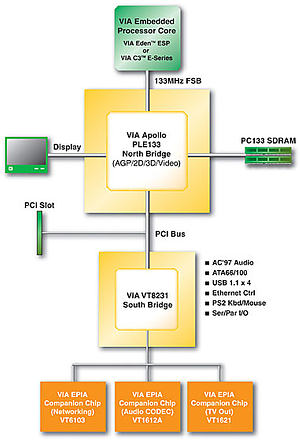 The board is based on the VIA Apollo PLE133 chipset (VT8601A, integrated AGP 2x graphics, VT8231 South Bridge), compatible with Micro ATX chassis; it supports 100/133 MHz FSB VIA Eden ESP 5000 and 100/133 MHz FSB VIA C3 E (EBGA) processors, has two PC100/133 DIMM SDRAM sockets, integrated 10/100 Ethernet LAN adapter, TV-Out, AC'97 audio codec (VT1612A), S/PDIF interface, four USB ports, and a PCI slot.  The quoted price of EPIA is rather attractive: the VIA EdenT ESP5000 bundle costs $99, the package with 800 MHz C3 E processor - $109. Many have recently become interested in the creation of home "low-noise" multimedia PCs, so such nicely priced solutions are just bound to be successful. Among the April serious server solutions I'd like to note the dual-processor DPX from IWILL on the Intel iE7500 chipset (E7500 Plumas + ICH3-S). 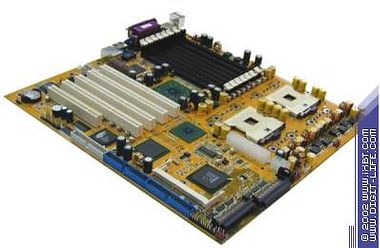 The board supports up to two Socket 603/604 FCBGA ZIF Intel Xeon (Prestonia) processors, and has four 64-bit PCI-X slots, a single 32-bit PCI slot, eight DDR DIMM slots (up to 16 GBytes of DDR266 ECC reg. SDRAM), two 10/100/1000 Fast Ethernet controllers (Intel 82544GC and Intel 82562ET), dual-channel Ultra 320 SCSI controller (Adaptec 7899W/7902) supporting Raptor Zero-Channel RAID (ZCR), and also the ATI Rage XL integrated video controller. Of the exotic novelties I'd like to mark the server MicroATX MS-6394 board from MSI on the ServerWorks's ServerSet LC-T chipset for Pentium III (Tualatin). 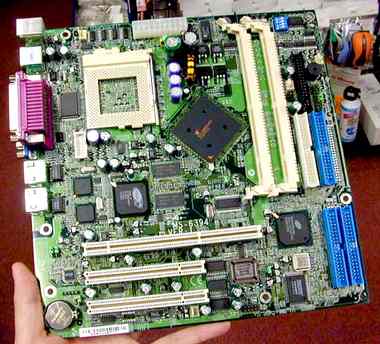 According to the chipset specifications, ServerWorks ServerSet LC-T consists of the NB6635 North Bridge and the IB6566 South Bridge, interconnected by 665 MBytes/s bus. Though MS-6394 features SB7440 I/O bridge (PCI-LPC) instead of the IB6566. The bundle is codenamed ServerWorks LC-T + ServerWorks CSB5 in the ServerWorks's papers.
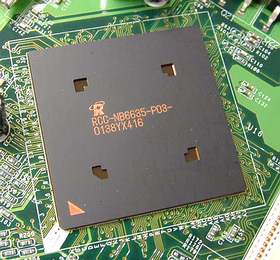 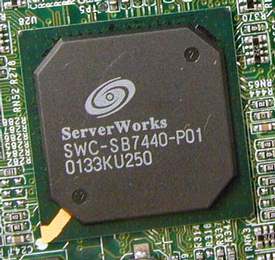 It supports up to 2 GBytes PC133 SDRAM, has one 64-bit/66 MHz and two 32-áèt/33 MHz PCI slots, integrated 10Base-T/100Base-TX (Intel i82550), video (ATI Rage XL, 4 MBytes VRAM), and Ultra ATA/100 IDE RAID (Promise PDC20265R) controllers. It's a good solution for a compact file- or web-server on a Socket370 CPU. April brought the message on two freshman companies on the enough saturated mainboard market. The first of them, Albatron, formerly known as Chun Yun Electronic, has already presented its first Albatron KX400+ board on the VIA KT333 chipset, planning to present yet seven or eight boards for AMD and Pentium 4 before the end of May. It's already known that one of them will feature the SiS650 chipset. The second freshman is the Hua Ching company. We assume it will be a successful enterprise for inexpensive boards production, being a subsidiary of Asustek. The business model of Hua Ching is close to the methods of ECS and its PC Chips subdivision. The growing Chinese market will be the major outlet of the enterprise. Memory productsDRAM prices that have been reducing since the recent month, continued to drop in this one and quickly reached the critical level of $3 per a nominal 128 Mbit chip, occasionally dropping even deeper. For the majority of DRAM manufacturers this means at least the rollback to the unprofitableness. I'd pick out the season factor from the general and predictable reasons for the price reduction: the RAM demand is very low on the Taiwanese exchanges; European stocks are overloaded as well as stocks in USA and Asia. Nevertheless, the production volume greatly exceeds the demand. Despite the spot prices have been occasionally jumping sometimes during the months, the general reduction has continued since the middle of March. Many analysts believe that contract prices will also reduce in the nearest future, but most likely not below the spot prices. The contract prices have been prevailing over spot prices for the longest time already. The supposed growth of memory demand on the threshold of i845G boards release hasn't happened yet. Now manufacturers are forced to reconsider their optimistic forecasts for the second quarter. So, May started with spot prices below $3, and the second cycle of price wars, like the one that have been exhausting the memory products market for the entire last year, might take place. Buyers are happy due to obvious reasons and have nothing against returning to the prices of the last fall. ;-) DRAM prices are expected to reduce until the middle of May. Then, according to analysts, there might be some growth due to memory shipment contracts of some companies and Taiwanese manufacturers. April put an end to the haggle of Micron and Hynix. The former, having bargained 108.6 million shares for $3.2 billion and $200 million investment into the "non-memory" Hynix's business, stumbled upon the uncompromising veto of Hynix's committee of directors, having unanimously rejected Micron's offer concerning memory factories purchase. Perhaps, directors were affected by strikes of workers, unwilling to labour for Americans; or maybe the sum offered by Micron was not enough. It's unimportant already. Now Hynix doesn't want any alliances, going to sell some non-DRAM manufacture remnants and progress investing into the most advanced technologies like the new 300-mm wafer fab. Hynix awaits the memory market to recover, believing it will be able to return the 6.5-billion debt itself. I'd like to mention some interesting April novelties, including the low-profile 1 and 2 GBytes DDR PC2100 Registered ECC modules from Kingston. They were developed in the close association with SuperMicro and Tyan Computer mainboard manufacturers and are intended for server solution, including server blades. 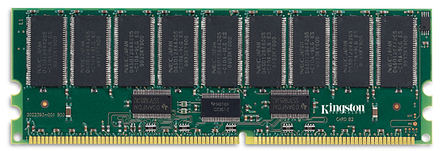 1 GBytes Low-Profile DDR PC2100 Registered ECC DIMM and 2 GBytes Low-Profile DDR PC2100 Registered ECC DIMM units are 1.2" in height (30.5 mm), feature CAS latency 2.5, 2.5 W supply voltage. Transcend released another low-profile memory unit in the SO-DIMM package in April. Its 256 and 512 MBytes ECC SO-DIMM modules have 1.25" (31.mm) height and are based on the wBGA (window Ball Grid Array) chips on the 6-layer circuit board. 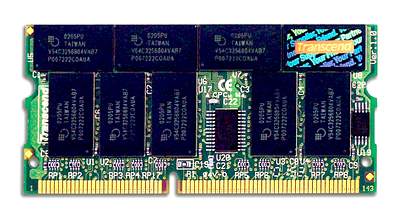 The new units are meant for industrial PCs, Cisco routers, Sun notebooks - in other words, for any device, requiring the low-profile memory. Video
During April GeForce4 cards became a usual thing in retail and manufacturers traditionally started to announce versions on held chip modifications as well as release cards featuring a variety of inputs and outputs, memory capacities and sizes. NVIDIA released a "bro" to the SDRAM GeForce4 MX420 supporting DDR architecture. Or rather GeForce4 MX420 along with the whole NV17 family supports DDR, but it was decided to position it as an SDRAM solution due to the high price of DDR chips. As the price difference between these two memory types has become unnoticeable, it doesn't make the economic sense to promote GeForce4 MX420 only as an SDRAM solution. It resulted in its DDR version. Gainward was the first to announce such a card: GeForce4 PowerPack! Model Pro/450 TV. Announces of cards on another held chip, GeForce4 Ti4200, were often reported in the April news. Cards on NVIDIA GeForce4 Ti4200 are mostly packaged with 64 MBytes DDR working at 500 MHz or with 128 MBytes 444 MHz DDR. Both versions feature the 250 MHz chip. GeForce 4 Ti became completed after the appearance of the A3 stepping. 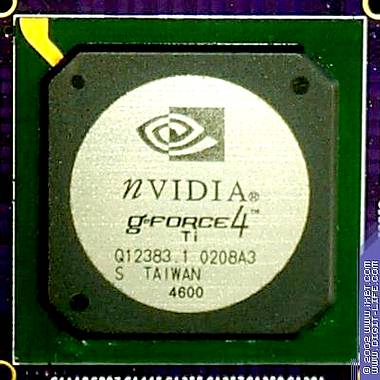 Unlike it, the previous A2 stepping version has been being marked "NV25" until the very end. Japanese Canopus released perhaps the most exotic GeForce4 product, having announced the SPECTRA WX25 on NVIDIA GeForce4 Ti4600. 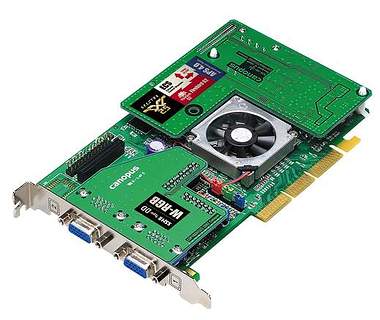 SPECTRA WX25 design is completely unlike the NVIDIA GeForce4 Ti4600 reference design, it is small-sized, as a power stabilizer and 2D unit are situated on separate daughter cards. Besides the reduced board size, this enables to lower the noise level. It also supports the second monitor (W-RGB feature). Visiontek released a PCI version of Xtasy PCI Edition on GeForce4 MX420. It has the standard analog and TV outputs, 64 MBytes VRAM.  April brought the mobile version of the new-generation professional NVIDIA Quadro4 XGL graphics chipset - Quadro4 500 Go GL for mobile workstations. Quadro4 500 Go GL combines the Lightspeed Memory Architecture II (LMA II) with up to 64 MBytes 128-bit memory support, PowerMizer mode and the multi-display nView technology. As well as the whole Quadro4 line, Quadro4 500 Go GL features the NVIDIA Unified Driver Architecture (UDA). Dell was the first to announce Precision M50 mobile workstations powered by Quadro4 500 Go GL. In the beginning of the month ATI and Pinnacle announced the partnership program. According to it, Pinnacle plans to use ATi developments as the hardware platform for its future video-editing solutions. In response ATi promised to distribute Pinnacle software with its WONDER family products. Most news concerning ATI is reported from company's numerous partners, manufacturing various and sometimes surprising ATI RADEON videocards. However ATI itself released the new product as well: the radio-frequency REMOTE WONDER remote control for PCs with ATI RADEON graphics. 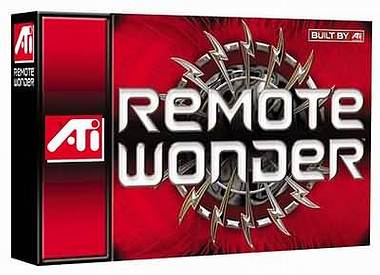  The remote can imitate mouse, has programmable buttons, provides remote control of multimedia features of various Windows applications, including software, packaged with ATI RADEON products like ATI Multimedia Center. It's already familiar to ALL-IN-WONDER owners. Besides, the last month brought the official sales of the universal ALL-IN-WONDER RADEON 8500 128 MBytes card, announced in March. 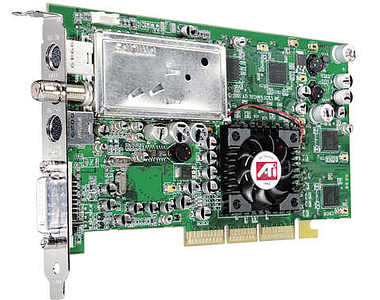 It has 128 MBytes in FBGA packages, a 125-channel TV tuner, remote control, etc. The rest corresponds to the features of 64 MBytes ALL-IN-WONDER RADEON 8500. I'd like to pick out the Daytona RADEON 8500 from Palit as one of the most interesting novelties on ATI RADEON. 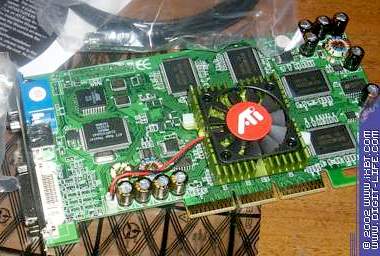 It bases on Radeon 8500LE chip with 250/240 (480 DDR) MHz chip/memory clock rates. First, it's design is unlike the ATi reference, and second, it features SGRAM instead of the standard SDRAM memory. Another novelty - 3D Blaster 4 RX7500 on RADEON 7500LE from Creative is interesting because ATI hasn't announced RADEON 7500LE officially. 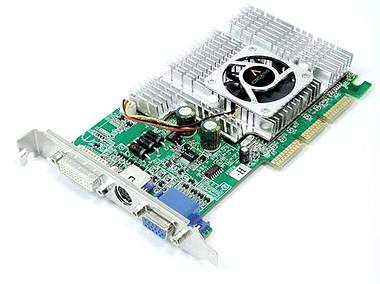 RADEON 7500LE works at 256 MHz, its memory - at 160 MHz. The card features analog, digital DVI and TV outputs. The highest resolution is 2048 x 1536 (analog output), 1600 x 1200 (digital output), 1024 x 768 (TV-out). 
 The official announce of SiS Xabre 400, one of the first GPU of the new SiS Xabre (or SiS33x) family was one of the most important events of April. Xabre 400 supports AGP 8x according to the so-called 8x8 formula (AGP 8x and DirectX8.1). Xabre400 core works at 250 MHz, memory (DDR) - at 500 MHz. SiS Xabre400 main features:
The mass deliveries of SiS Xabre 400 are expected in the second half of May. Cards on this chip were already announced by Elitegroup, Gigabyte, Triplex, AOpen, Chaintech, and C.P. Technology (below: the card from Triplex). 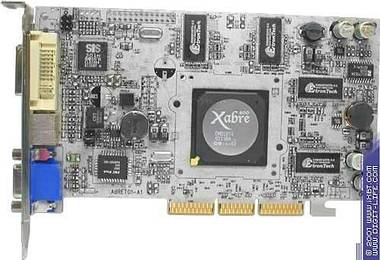 Other SiS33x Xabre series chips: SiS328, SiS332, and SiS336 to be named Xabre 80, Xabre 200, and Xabre 600, respectively, have not been announced yet. I guess it'll officially happen at Taiwan Computex 2002 in June. Displays
Two main monitor themes of April: TFT LCD prices increase and the new prospective technologies, presented at EDEX2002 in Tokyo. Though, the former threads through all latest months. The consistent TFT LCD panel prices increase by Taiwanese manufacturers resulted in the Japanese companies doing the same. NEC-Mitsubishi Electric Visual Systems (NMV), for example, raised the prices for its 15" TFT LCD monitors by 4000 - 5000 yens or about $30-40, or by almost 10% of the previous level. LCD monitors really came into fashion now and the demand for 15" panels is now greater than production volumes. Besides, you shouldn't forget the stable demand for notebooks. Due to this the price increase is planned to May. Samsung Electronics announced the additional price increase for 14.1" and 15" TFT LCD notebook panels, by average $10-15. Of course, Taiwanese manufacturers are to follow it. Samsung also increases prices for 15" TFT LCD monitor panels by average $5. It's expected that the increase of prices for 15" TFT LCD notebook panels, that made the average 5.3% in April, will continue in May. This situation is the result of that many Japanese LCD panel manufacturers, such as NEC and Fujitsu, transited to larger-inch products. I suspect this will affect notebook retail prices soon enough, most likely the inexpensive models. Compal Electronics has already warned that Intel's price reduction for P4-M CPUs, expected in the end of May, will compensate the expensiveness of LCD panels for hi-end notebooks, though won't save the release prices for inexpensive models from growth. Many manufacturers name the release price of $300 for 15" panel critical. After this level is passed, the prices for inexpensive notebooks will jump from $900 up to $1000 and higher. But let's finish with economics. Display manufacturers prepared many new products and technologies for the Electronic Display Exhibition 2002 that took place on 16-18 of April in Tokyo. I'd like to note that the spotlight was projected at organic electro-luminescent displays, pretending to become a future standard. Many companies are going to launch the mass production of organic EL panels in the near future. The organic EL panels have the unique feature to emit light as the current passes through the display elements. Thus making the standard for LCD panels backlight requirement obsolete. Moreover, organic displays consume less energy, are thinner and feature better color rendition. Some versions of such displays are now used in current electronics already, for example, Pioneer uses monochrome EL panels in its automobile audio devices; these displays are also used in FOMA-standard mobiles (N2001) from NEC. At EDEX 2002 the Toshiba Matsushita Display Technology Co., Ltd. joint enterprise has showed the first prototypes of 17" EL displays to appear on the market in the nearest two or three years (15" versions have been demonstrated before). The prototypes feature up to 100-300 candles/sq.m, 1:200 contrast and display up to 260 thousand colors per dot in the XGA (1280 x 768) resolution.  Hitachi presented its 17" TFT LCD panel with increased transparency and improved aperture (due to the modified positional relationship of electrodes and black matrix). The maximum brightness is 300 candles/sq.m at about 22 W of consumed power. The panel is backlit from its four corners. 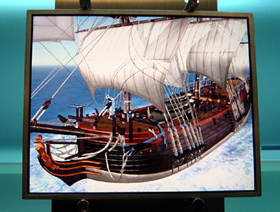 NEC showed off the 18.1" SXGA panel with the improved aperture due to the new technical process and revised architecture. The maximum brightness is 340 candles/sq.m, that's 40% more than traditional panels have. The low-inch panels, designed for mobiles and PDAs, became the mass exhibits. They were showed off by Toshiba Matsushita Display Technology, Seiko Epson, Sanyo Electric, NEC, and Tohoku Pioneer. There were several prototypes of hi-res LCD panels for mobiles and PDAs. Seiko Epson presented the TFD LCD panel with 200 ppi (pixels per inch) resolution. Unlike the majority of other hi-res panels, traditionally made according to low-temperature polycrystalline silicon, Seiko Epson panels are made according to the economical and inexpensive TFD technology. The semi-transparent screen is 2" in diagonal, 240 x 320 in size, 260 thousand colors per dot capacity and 60:1 contrast. NEC presented the 2.2" semi-transparent TFT LCD 176 x 220 panel with up to 260 thousand colors at the maximum of 60 candles/sq.m and 31% reflectance. The panel's contrast is 150:1 in the semi-transparent mode and 7:1 in the reflective mode. Panel's energy consumption is 2 milliwatt for the 8-color mode and increases up to 6.8 milliwatt in the 260 thousand color mode. The response time is 32 ms.  Besides, NEC reported the development of 3.5" semi-transparent TFT LCD module on amorphous silicon. NL2432HC22-20 supplied with a driver and reflective system is designed for the new-generation pocket PCs. It provides 240 x 320 (76800 pixels, 230400 dots) image size with 262144 colors per dot depth (64 RGB gradations; 0.2235 mm horizontal x 0.2235 mm vertical dot step). The semi-transparent panel features 20% reflectance and 30:1 contrast in the reflective mode. In the transparent mode it features 4% transparentness and 100:1 contrast. This enables to use the screen even at the very strong external illumination. The screen back-light system features 6 LEDs. The assembled unit is only 3.5 mm thick and weighs 30 gr. The power consumption is about 25 milliwatt. 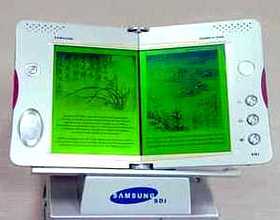 Samsung released the interesting 170 x 127 mm LCD display, that folds like a book. The company believes that it provides better image quality at lower power consumption than usual LCD screens. Samsung plans to use the "fold-screen" in portable e-books. 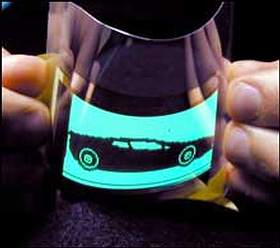 Universal Display reported the development of the FOLED (Flexible Organic Light Emitting Device) technology, using the flexible substrate. It says that FOLED are highly competitive with usual LCD screens, being better in some features, cheaper and - what's important -more reliable, not being the subject to inelastic deformations. Notebooks
April brought the really mass deliveries of Transmeta Crusoe TM5800 processors. It has been proved by the appearance of completely new models in April - besides the last-year Sony and Fujitsu notebooks - not concepts, but serial products to be massively sold in April/May. Sony announced the Bio PCG-U1 model ($1150), being a miniature light notebooks, sized 184.5 x 139 x 30.6 mm and weighing 820 gr. 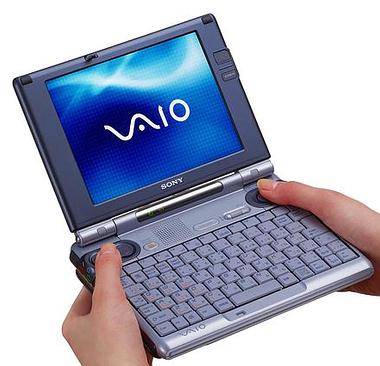 It has 867 MHz Crusoe TM5800 CPU, 256 MBytes RAM, 20 GBytes Ultra ATA/100 HDD, ATI MOBILITY Radeon-M (8 MBytes) graphics, 6.4" 1024 x 768 (XGA) TFT LCD display, pre-installed Windows XP Home Edition. Toshiba continued to partner with Transmeta, having released two sub-notebooks: Libretto L5 - L5/080TNKW ($1300, Windows XP Pro) and L5/080TNLN ($1050, Windows XP Home). They differ by the integrated radio LAN IEEE 802.11b interface of the senior L5/080TNKW model, and 1.8" HDD instead of usual 2.5" HDD (the junior L5/080TNLN model still uses 2.5" HDD). 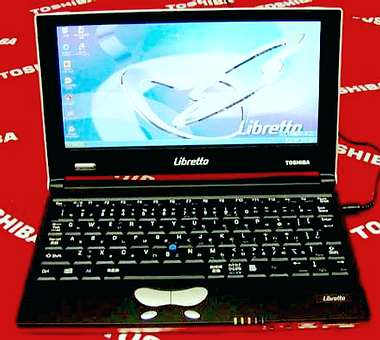 Both models have 800 MHz TM5800 CPU and ALi M1535B chipset, 256 MBytes RAM (up to 512 MBytes), 20 GBytes HDD, 10" 1280 x 600 LCD panel on low-temperature polycrystalline silicon, ATI MOBILITY RADEON M6-M (8 MBytes) graphics. The novelties are sized 268 x 167.2 x 20.5 mm and weigh 1.1 kg. At the Microsoft WinHec conference Transmeta showed the prototype of a pocket OQO PC on the 1 GHz ïpoöeccope Crusoe TM5800 controlled by Windows XP Professional, and being 105 x 74 x 22 mm in size, weighing 250 gr. 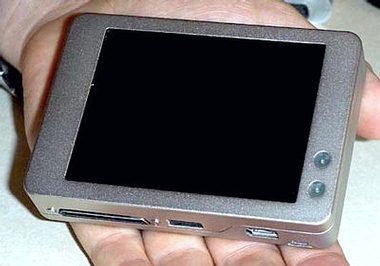
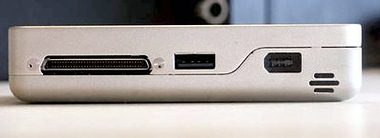 Despite the light weight and small size, its has more from a notebook than from a PDA: separate video engine (SMI or ATI), up to 256 MBytes RAM, 1.8" HDD (up to 10 GBytes), 4" 640 x 480 (VGA) touch screen, Network Radio LAN (IEEE 802.11b) and Bluetooth interfaces. It seems that presenting this PC Transmeta plans to remind of itself and prove that solutions on its new Crusoe TM5800 are capable of finding their niche among below $1000 miniature PCs. The interesting NT10FP1800 notebook ($1740-2650) with a dactyloscopic user authentification sensor was launched for sale by Samsung. 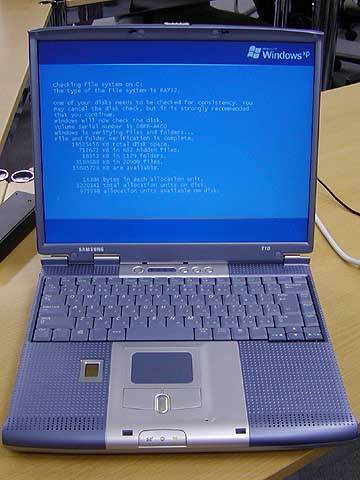 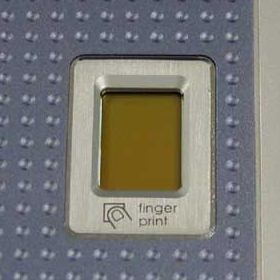 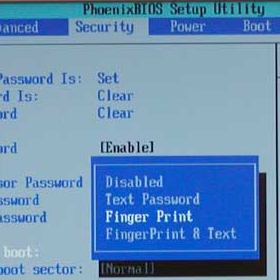 It has 15" 1400 x 1050 (SXGA+) TFT LCD display, 1.4 - 1.8 GHz Mobile Pentium 4-M CPU (Intel 845MP chipset), RADEON 7500 (32 MBytes DDR) graphics, 512 MBytes RAM (2 x 256 MBytes DDR), 40 GBytes HDD, 8/8/8/24 DVD/CD-RW combo. Notebook size is 324 x 272 x 41 mm, weight - 3.3 kg. The authentification system is rather interesting: fingerprint certification can be initiated both at BIOS read, and at Windows boot. BIOS even has a special "Boot Security function", enabling to tune the notebook for its owner. Besides, there's the additional HDD "FileDisk Protective Function", fingerprint-programmable as well. IBM announced the new ThinkPad T30 models ($2499 to $3499). ThinkPad T30 is equipped with up to 1.8 GHz Mobile Intel Pentium 4-M or 1.2 GHz Mobile Intel Pentium III-M (T23 series), 256 MBytes (up to 1 GBytes) PC266 DDR SDRAM or PC133 SDRAM, up to 60 GBytes HDD, 14.1" SXGA+ screen with up to 1400x1050 resolution, ATI Mobility Radeon 7500 AGP 4x (16 MBytes DDR) graphics, CD-RW/DVD Combo II, CD-RW, or DVD drive, integrated wireless 802.11b or Bluetooth interfaces (some models).  The IBM ThinkPad T30 series is interesting because these PCs are the first to feature chips supporting TCPA 1.1 (Trusted Computing Platform Alliance) standard adopted by Compaq, IBM, HP, Intel, and Microsoft. In particular, T30 will feature Atmel Corporation microprocessor. Now TCPA is held by imperfections of version 1.1. Many vendors do not hurry to promote this standard, though its application field is already at hand so to say. Until the release of version 1.2 and until Microsoft adds the OS-level support, we shouldn't wait for noticeable breakthroughs in this field. Closer to the end I'd like to mention the Mebius PC-GP1-C7H ($1750) notebook from Sharp to appear in USA retail in May. The model is interesting due to used 0.13-micron AMD Mobile Athlon XP 1400+ CPU. 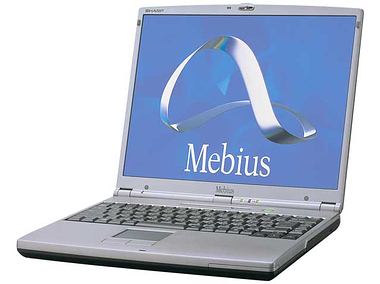 The notebook features the integrated ProSavage
KN133 chipset, 15" 1024 x 768 TFT LCD, 256 MBytes PC133 (up to 1152
MBytes) RAM, 40 GBytes HDD, 8/8/8/24 DVD/CD-RW combo, FDD. The novelty
size is 324 x 277 x 39 mm, weight - 3.8 kg.
Write a comment below. No registration needed!
|
Platform · Video · Multimedia · Mobile · Other || About us & Privacy policy · Twitter · Facebook Copyright © Byrds Research & Publishing, Ltd., 1997–2011. All rights reserved. |